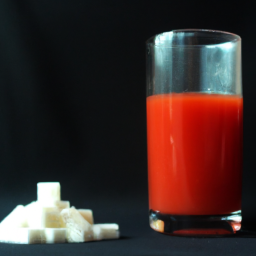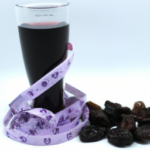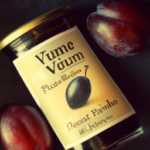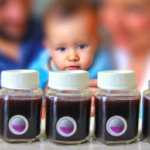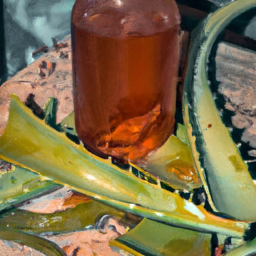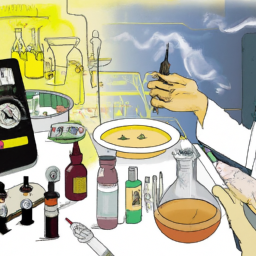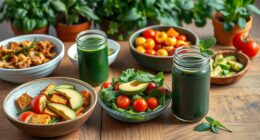Have you ever stopped to think about the sugar content in prune juice, a popular drink known for its sweet and tangy flavor enjoyed by many?
As a nutritionist, I have come across many clients who are concerned about their sugar intake and the impact it may have on their health. In this article, we will explore the sugar content of prune juice, compare it to other beverages, and discuss its effects on our health.
Sugar is an essential nutrient that our body needs to function properly. However, excessive sugar consumption has been linked to many health problems such as obesity, diabetes, and heart diseases. As such, it is crucial to be mindful of our sugar intake and make informed choices when it comes to the foods and beverages we consume.
With that in mind, let’s delve into the world of prune juice and see how much sugar it contains.
Key Takeaways
- Prune juice contains natural sugars and approximately 22 grams of sugar per cup, similar to orange juice and less than Coca-Cola.
- While prune juice is a good source of carbohydrates, fiber, and essential vitamins and minerals, it should be consumed in moderation due to its high sugar content.
- Prune juice may not be suitable for individuals with diabetes or other conditions that require sugar control, and reading nutrition labels is crucial for understanding the amount of sugar in prune juice.
- To reduce sugar intake, healthy alternatives like sparkling water with fruit slices, fresh fruit, and plain Greek yogurt with fresh fruit can be consumed, and sugar substitutes like stevia, honey, and maple syrup can be used in cooking and baking. Hidden sources of sugar in foods and beverages should be avoided by reading nutrition labels carefully and choosing whole foods over processed and packaged foods.
Understanding the Importance of Sugar in Our Diets
Understanding the importance of sugar in our diets is crucial, as it can impact our overall health and well-being. While sugar is a vital source of energy for our bodies, overconsumption can lead to a range of health problems, including weight gain, dental issues, and an increased risk of chronic diseases. Therefore, it’s essential to practice moderation when it comes to sugar intake.
Fortunately, there are many sugar-free alternatives available that can help us reduce our sugar intake without sacrificing taste. For instance, we can swap out sugary drinks like soda and juice for water, unsweetened tea, or flavored water. Additionally, we can choose snacks that are low in sugar, such as fresh fruit, nuts, and seeds.
By making these small changes to our diets, we can maintain a healthy balance of sugar intake and improve our overall health. With that said, let’s delve into the nutritional content of prune juice.
Nutritional Content of Prune Juice
As I explore the nutritional content of prune juice, two key points stand out to me. It’s relatively low in calories, with an 8-ounce serving containing around 120 calories. In terms of macronutrients, it’s a good source of carbohydrates and fiber, but is relatively low in protein and fat.
Additionally, prune juice contains a variety of vitamins and minerals, such as vitamin K, potassium, and iron. These are important for overall health and wellbeing.
Calories and Macronutrient Composition
The prune juice packs a powerful punch of sugar and saturated fat, so be mindful of your consumption if you’re counting calories. One cup of prune juice contains around 182 calories, with most of those coming from carbohydrates. Prune juice also contains a moderate amount of protein and a negligible amount of fat, making it a good source of energy for those who need a quick boost.
If you’re looking for a lower sugar alternative to prune juice, consider swapping it out for unsweetened apple or cranberry juice. Additionally, sugar substitutes like stevia or monk fruit can be used to sweeten your juice without adding any calories or sugar. It’s important to note that while these substitutes may be a healthier option for some, they should still be consumed in moderation.
Moving on to the next section about vitamins and minerals, it’s important to note that prune juice is also a good source of certain nutrients.
Vitamins and Minerals
Get ready to learn about the essential vitamins and minerals found in prune juice. This drink isn’t just tasty but also packed with nutrients that can benefit your health.
Here are three key vitamins and minerals found in prune juice, along with their sources and functions:
-
Vitamin K: Prune juice is an excellent source of vitamin K, which plays a crucial role in blood clotting. It’s also essential for bone health, as it helps the body absorb calcium and prevents bone loss.
-
Potassium: Prune juice is a good source of potassium, which helps regulate fluid balance in the body and supports healthy blood pressure levels. It also plays a role in muscle contraction and nerve function.
-
Iron: Prune juice contains iron, which is essential for the formation of hemoglobin, the protein in red blood cells that carries oxygen throughout the body. Iron is also important for energy production and immune function.
Deficiencies in these vitamins and minerals can lead to various health risks. For example, a lack of vitamin K can increase the risk of bleeding, while low levels of potassium can lead to high blood pressure and muscle weakness. Iron deficiency can cause anemia, fatigue, and weakened immunity. It’s important to ensure that you’re getting enough of these nutrients through a balanced diet or supplementation.
Moving on to the sugar content of prune juice, it’s important to note that while it does contain natural sugars, the amount can vary depending on the brand and processing method.
Sugar Content of Prune Juice
Hey, did you know that a cup of prune juice contains about 22 grams of sugar, which is almost as much as a can of soda? Although prune juice is marketed as a healthy drink due to its high fiber and vitamin content, its sugar content should not be overlooked. For those who are watching their sugar intake, there are prune juice alternatives available, such as sugar-free prune juice options.
To give you a better idea of the sugar content in different beverages, here’s a table that compares the sugar content in one cup of various drinks:
| Beverage | Sugar Content |
|---|---|
| Prune Juice | 22g |
| Orange Juice | 21g |
| Coca-Cola | 26g |
As you can see, prune juice contains a similar amount of sugar as orange juice, and even less than Coca-Cola. However, it’s important to note that too much sugar intake can lead to health problems such as obesity and diabetes. So, it’s always a good idea to monitor your sugar intake and choose lower sugar alternatives when possible. In the next section, we’ll take a closer look at how prune juice compares to other popular beverages.
Comparing Prune Juice to Other Beverages
Let’s take a closer look at how prune juice stacks up against other popular beverages in terms of their nutritional content. When comparing taste, prune juice has a unique sweet and tart flavor that may not be for everyone. However, it’s important to note that prune juice is a natural source of sugar and doesn’t contain added sugars like many other beverages on the market today.
In terms of cost, prune juice may be slightly more expensive than some sodas or sports drinks, but it’s still a relatively affordable option for those looking to add more fruit juice to their diet.
When looking at the nutritional content of other popular beverages, it becomes clear that prune juice is a healthier option. For example, a 12-ounce can of soda can contain as much as 39 grams of sugar, while a 12-ounce serving of prune juice contains only 24 grams of sugar. Additionally, many sports drinks and energy drinks contain added sugars and artificial sweeteners, making them less healthy choices overall.
When it comes to choosing a beverage, it’s important to consider not only taste and cost but also the impact it will have on your overall health. Transitioning into the next section, it’s important to note that while prune juice may be a healthier option than many other beverages, it still contains a significant amount of sugar.
In the next section, we’ll explore the effects of sugar on our health and how we can make informed choices when it comes to our diets.
Effects of Sugar on Our Health
Sugar is like a double-edged sword—it may taste sweet and delicious, but it can also have detrimental effects on our health.
The impact of excess sugar on our bodies is significant. Consuming too much sugar can lead to weight gain, tooth decay, and an increased risk of chronic diseases such as diabetes, heart disease, and cancer.
Fortunately, there are strategies for reducing sugar intake. These include reading food labels to identify added sugars, choosing whole foods over processed ones, and using natural sweeteners like honey or maple syrup in moderation.
By being mindful of our sugar intake and making small changes to our diet, we can improve our overall health and reduce the risk of chronic diseases. With moderation and portion control, we can enjoy the sweet taste of sugar without compromising our health.
Moderation and Portion Control
As someone who’s conscious about my health, I know the importance of moderation and portion control when it comes to sugar intake. The American Heart Association recommends that women consume no more than 6 teaspoons of added sugar per day, while men should have no more than 9 teaspoons.
To limit my sugar consumption, I opt for natural sweeteners like fruits and honey, and try to avoid processed and packaged foods that are high in added sugars.
Recommended Daily Sugar Intake
Limiting your daily sugar intake is crucial for maintaining a healthy lifestyle, as consuming too much sugar can lead to various health problems such as weight gain, diabetes, and heart disease. The American Heart Association recommends that men consume no more than 9 teaspoons (36 grams) of added sugar per day, while women should consume no more than 6 teaspoons (24 grams) per day. However, the average American consumes around 17 teaspoons (68 grams) of added sugar daily, which is more than double the recommended amount.
To help make it easier to monitor your sugar intake, incorporating healthy alternatives and sugar-free options can be beneficial. Below is a table showcasing some examples of these alternatives:
| Sugary Food/Drink | Healthy Alternative/Sugar-Free Option |
|---|---|
| Soda | Sparkling water with fruit slices |
| Candy | Fresh fruit |
| Ice cream | Frozen yogurt or fruit sorbet |
| Sweetened yogurt | Plain Greek yogurt with fresh fruit |
By incorporating these options into your diet, you can still satisfy your sweet tooth without overloading on sugar. In the next section, we will discuss tips for limiting sugar consumption without sacrificing taste or enjoyment of food.
Tips for Limiting Sugar Consumption
You must be thrilled to know that there are many delicious ways to cut back on your sugar intake without feeling like you’re sacrificing anything. One way to limit your sugar consumption is to choose healthy alternatives to satisfy your sweet tooth.
For example, instead of reaching for candy or a sugary drink, try satisfying your craving with a piece of fruit or a handful of nuts. You can also opt for sugar-free snacks like popcorn or low-sugar yogurts. By making these simple swaps, you can significantly reduce your daily sugar intake without feeling like you’re missing out on anything.
Another way to limit your sugar consumption is to use sugar substitutes in your cooking and baking. There are many natural sugar substitutes available, such as stevia, honey, and maple syrup. These alternatives can help you cut back on sugar without sacrificing flavor.
It’s also important to read food labels and be aware of hidden sources of sugar in processed foods. By making these changes, you can enjoy a healthier lifestyle and reduce your risk of health problems associated with high sugar intake.
Now, let’s move on to the benefits of prune juice.
Benefits of Prune Juice
Feeling sluggish? Boost your digestive health with the numerous benefits of prune juice.
Prune juice is an excellent source of fiber, which can aid in digestion and promote regular bowel movements. It also contains sorbitol, a natural laxative that can help alleviate constipation.
Prune juice can be consumed on its own or used to create delicious recipes, such as prune juice smoothies or baked goods. However, it’s important to consume prune juice in moderation as it’s high in sugar.
While it can provide many benefits for digestive health, individuals with diabetes or other conditions that require sugar control should be cautious when consuming prune juice.
Who Should Be Cautious When Consuming Prune Juice
It’s important to tread carefully when drinking prune juice, as certain individuals with specific health conditions may need to exercise caution. Here are a few things to keep in mind:
-
Prune juice and medication interactions: If you’re taking certain medications, such as blood thinners, it’s important to talk to your doctor before consuming prune juice. Prune juice contains vitamin K, which can interfere with these medications and affect their effectiveness.
-
Potential side effects of consuming too much prune juice: While prune juice is generally safe to consume, drinking large amounts can lead to some uncomfortable side effects, such as diarrhea and bloating. This is because prune juice is high in fiber and sorbitol, which can act as a laxative.
-
Individuals with IBS or other digestive issues may also want to limit their intake of prune juice, as it can worsen symptoms.
It’s important to keep these factors in mind when deciding whether or not to consume prune juice. In the next section, we’ll discuss some tips for choosing the right prune juice for your needs.
Tips for Choosing Prune Juice
When it comes to choosing prune juice, I always make sure to read the nutrition labels carefully. This helps me determine the amount of sugar, calories, and other nutrients in the juice.
Additionally, I try to avoid prune juice that contains added sugars, which can contribute to health issues such as diabetes and obesity.
By being mindful of these factors, I can ensure that I’m making a healthy and informed choice when selecting prune juice.
Reading Nutrition Labels
To get a better understanding of the amount of sugar in prune juice, I always take a closer look at the nutrition label. This provides valuable information about the serving size and daily percentage of sugar intake. Here are some tips for how to read the label and compare different brands:
-
Look for the serving size: This information is crucial for understanding the amount of sugar in your drink. The serving size for prune juice is typically 8 ounces, so make sure to compare brands based on this standard.
-
Check the grams of sugar: The nutrition label will list the amount of sugar in grams per serving. Keep in mind that naturally occurring sugars, like those found in fruit, are different from added sugars.
-
Compare different brands: Some brands may add extra sugar to their prune juice, while others may not. Be sure to compare labels and choose a brand with the lowest amount of added sugar.
-
Consider your daily sugar intake: The nutrition label will also provide information on the daily percentage of sugar intake. Keep in mind that the American Heart Association recommends limiting added sugars to no more than 25 grams per day for women and 36 grams per day for men.
By understanding serving sizes and comparing sugar content in different brands, you can make an informed decision about which prune juice to choose. However, it’s important to also consider avoiding added sugars altogether to maintain a healthy diet.
Avoiding Added Sugars
Avoiding added sugars can be challenging, especially when consuming foods and drinks that are marketed as healthy options. Many people assume that natural and organic products are free from added sugars, but this isn’t always the case.
In fact, many so-called healthy alternatives contain hidden sugars that can be just as harmful to your health as regular sugar. To avoid added sugars, it’s important to read nutrition labels carefully and look for hidden sources of sugar, such as high fructose corn syrup, honey, and agave nectar.
It’s also important to choose whole foods over processed and packaged foods, as these tend to be higher in added sugars. When it comes to beverages, it’s best to choose water, unsweetened tea, or 100% fruit juice, rather than sugary drinks like soda or fruit punch.
With a little bit of effort and awareness, it’s possible to avoid added sugars and make healthier choices for your body.
Frequently Asked Questions
What are some alternatives to prune juice for those looking to reduce their sugar intake?
I’ve found some low-sugar options and nutritious alternatives to prune juice. Unsweetened almond milk, coconut water, and pomegranate juice are great choices. Green smoothies with leafy greens and berries are also delicious and healthy.
Can prune juice be consumed by individuals with diabetes or other blood sugar-related conditions?
As someone with diabetes, it’s important to manage my blood sugar levels. While prune juice does contain natural sugars, there are sugar substitutes available for those looking to reduce their intake and still enjoy the benefits of prune juice.
How does the sugar content in prune juice vary between different brands or types?
I was surprised to learn that the sugar content in prune juice varies greatly between brands and types. Some have added sugars, while others are all natural. It’s important to check the flavor profiles and nutritional value before buying.
Is there a recommended daily intake of prune juice for optimal health benefits?
To maximize the nutritional value of prune juice, a daily intake of 4-8 ounces is recommended. This amount provides fiber, vitamins, and minerals, which can aid digestion and promote overall health.
Are there any potential negative side effects of consuming too much sugar from prune juice?
Consuming excessive sugar from prune juice can lead to negative effects and health risks. High sugar intake can cause weight gain, tooth decay, and increase the risk of diabetes and heart disease.
Conclusion
So, how much sugar is in prune juice?
After researching and analyzing the nutritional content of prune juice, it’s clear that it contains a significant amount of sugar. In fact, one cup of prune juice can contain up to 31 grams of sugar, which is equivalent to 7.75 teaspoons of sugar.
This statistic may sound alarming, but it’s important to remember that moderation and portion control are key when it comes to consuming any type of food or beverage. While excessive sugar intake can lead to negative health effects, such as weight gain and increased risk of chronic diseases, consuming prune juice in moderation can provide numerous health benefits, such as aiding in digestion and promoting bone health.
It’s ultimately up to the individual to make informed choices about their diet and lifestyle.
Ilana has been a vegan for over 10 years. She originally made the switch for health reasons, but soon found herself becoming more and more passionate about the ethical and environmental implications of a vegan lifestyle. Ilana is the author of The Graceful Kitchen, a blog all about veganism. She loves to cook up delicious and nutritious vegan meals, and share her recipes with others who are interested in leading a cruelty-free life. Ilana is also a strong advocate for using whole foods as the foundation of a healthy diet, and believes that going vegan is one of the best ways to achieve this.

